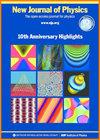Laser powered dissipative quantum batteries in atom-cavity QED
IF 2.8
2区 物理与天体物理
Q2 PHYSICS, MULTIDISCIPLINARY
引用次数: 0
Abstract
The interaction of a three-level atom with the electromagnetic field of a quantum cavity in the presence of a laser field presents a rich behavior in the dispersive regime that we exploit to discuss two quantum batteries. In the first setup, we consider a single three-level atom interacting sequentially with many cavities, each in a thermal state. We show that under this process, the atom converges towards an equilibrium state that displays population inversion. In the second setup, a stream of atoms in a thermal state interacts sequentially with a single cavity initially in a thermal state at the same temperature as the atoms. We show that the cavity’s energy increases continuously as the stream of atoms continues to cross, and the cavity does not reach an equilibrium state. After many atoms have traveled, the cavity’s state becomes active, storing extractable energy that increases in proportion to the work done by the laser. However, the same dynamics may involve only two cavity levels in an interesting limit called the highly selective regime. In that regime, the cavity reaches an equilibrium state similar to the one of the atom in the first scenario. The charging process we propose is robust. We discuss its thermodynamics and evaluate the energy supplied by the laser, the energy stored in the battery, and, thus, the device’s efficiency. We also analyze the role of damping.原子腔 QED 中的激光驱动耗散量子电池
在激光场存在的情况下,三量级原子与量子空腔电磁场的相互作用在色散机制中呈现出丰富的行为,我们利用这种行为来讨论两种量子电池。在第一种设置中,我们考虑了单个三量级原子依次与许多腔体相互作用的情况,每个腔体都处于热状态。我们证明,在这一过程中,原子会趋向于一种显示种群反转的平衡态。在第二种情况下,处于热态的原子流依次与最初处于热态的单个空穴相互作用,空穴的温度与原子的温度相同。我们的研究表明,随着原子流的不断穿过,空腔的能量不断增加,空腔并没有达到平衡状态。在许多原子穿越后,空腔状态开始活跃,储存的可提取能量与激光做功成正比增加。然而,在一个有趣的极限(称为高选择性状态)中,同样的动力学可能只涉及两个空腔水平。在这种情况下,空腔会达到与第一种情况下原子的平衡状态类似的状态。我们提出的充电过程是稳健的。我们讨论了其热力学原理,并评估了激光器提供的能量、电池中存储的能量以及设备的效率。我们还分析了阻尼的作用。
本文章由计算机程序翻译,如有差异,请以英文原文为准。
求助全文
约1分钟内获得全文
求助全文
来源期刊

New Journal of Physics
物理-物理:综合
CiteScore
6.20
自引率
3.00%
发文量
504
审稿时长
3.1 months
期刊介绍:
New Journal of Physics publishes across the whole of physics, encompassing pure, applied, theoretical and experimental research, as well as interdisciplinary topics where physics forms the central theme. All content is permanently free to read and the journal is funded by an article publication charge.
 求助内容:
求助内容: 应助结果提醒方式:
应助结果提醒方式:


